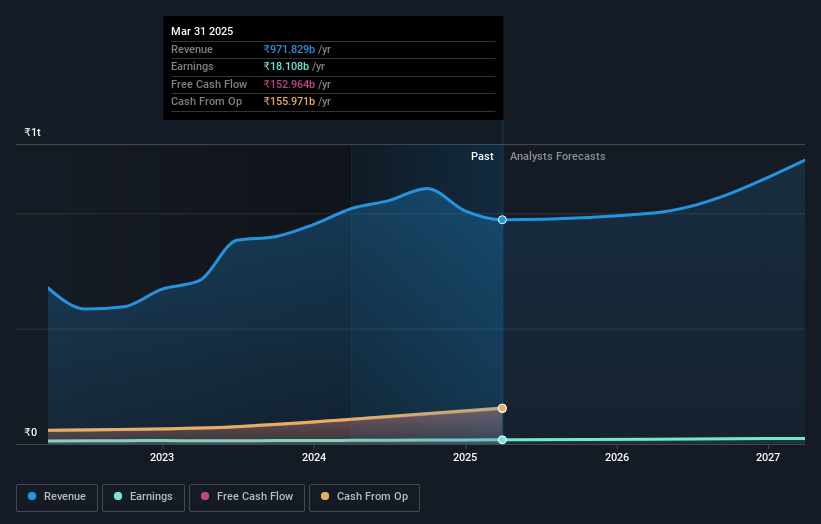Earnings Update: HDFC Life Insurance Company Limited (NSE:HDFCLIFE) Just Reported And Analysts Are Trimming Their Forecasts
HDFC Life Insurance Company Limited (NSE:HDFCLIFE) missed earnings with its latest yearly results, disappointing overly-optimistic forecasters. HDFC Life Insurance missed analyst forecasts, with revenues of ₹972b and statutory earnings per share (EPS) of ₹8.41, falling short by 5.0% and 2.5% respectively. The analysts typically update their forecasts at each earnings report, and we can judge from their estimates whether their view of the company has changed or if there are any new concerns to be aware of. With this in mind, we've gathered the latest statutory forecasts to see what the analysts are expecting for next year.

Taking into account the latest results, the consensus forecast from HDFC Life Insurance's eight analysts is for revenues of ₹1.00t in 2026. This reflects a modest 3.0% improvement in revenue compared to the last 12 months. Statutory earnings per share are predicted to step up 13% to ₹9.51. In the lead-up to this report, the analysts had been modelling revenues of ₹1.14t and earnings per share (EPS) of ₹10.01 in 2026. It looks like sentiment has fallen somewhat in the aftermath of these results, with a real cut to revenue estimates and a minor downgrade to earnings per share numbers as well.
Check out our latest analysis for HDFC Life Insurance
Despite the cuts to forecast earnings, there was no real change to the ₹797 price target, showing that the analysts don't think the changes have a meaningful impact on its intrinsic value. Fixating on a single price target can be unwise though, since the consensus target is effectively the average of analyst price targets. As a result, some investors like to look at the range of estimates to see if there are any diverging opinions on the company's valuation. There are some variant perceptions on HDFC Life Insurance, with the most bullish analyst valuing it at ₹900 and the most bearish at ₹570 per share. These price targets show that analysts do have some differing views on the business, but the estimates do not vary enough to suggest to us that some are betting on wild success or utter failure.
Another way we can view these estimates is in the context of the bigger picture, such as how the forecasts stack up against past performance, and whether forecasts are more or less bullish relative to other companies in the industry. It's pretty clear that there is an expectation that HDFC Life Insurance's revenue growth will slow down substantially, with revenues to the end of 2026 expected to display 3.0% growth on an annualised basis. This is compared to a historical growth rate of 18% over the past five years. By way of comparison, the other companies in this industry with analyst coverage are forecast to grow their revenue at 9.5% per year. Factoring in the forecast slowdown in growth, it seems obvious that HDFC Life Insurance is also expected to grow slower than other industry participants.
The Bottom Line
The most important thing to take away is that the analysts downgraded their earnings per share estimates, showing that there has been a clear decline in sentiment following these results. On the negative side, they also downgraded their revenue estimates, and forecasts imply they will perform worse than the wider industry. The consensus price target held steady at ₹797, with the latest estimates not enough to have an impact on their price targets.
Keeping that in mind, we still think that the longer term trajectory of the business is much more important for investors to consider. We have forecasts for HDFC Life Insurance going out to 2027, and you can see them free on our platform here.
Plus, you should also learn about the 1 warning sign we've spotted with HDFC Life Insurance .
Have feedback on this article? Concerned about the content? Get in touch with us directly. Alternatively, email editorial-team (at) simplywallst.com.
This article by Simply Wall St is general in nature. We provide commentary based on historical data and analyst forecasts only using an unbiased methodology and our articles are not intended to be financial advice. It does not constitute a recommendation to buy or sell any stock, and does not take account of your objectives, or your financial situation. We aim to bring you long-term focused analysis driven by fundamental data. Note that our analysis may not factor in the latest price-sensitive company announcements or qualitative material. Simply Wall St has no position in any stocks mentioned.
- AMDG
- 9.79
- +10.37%
 Index Options
Index Options CME Group
CME Group Nasdaq
Nasdaq Cboe
Cboe TradingView
TradingView Wall Street Journal
Wall Street Journal